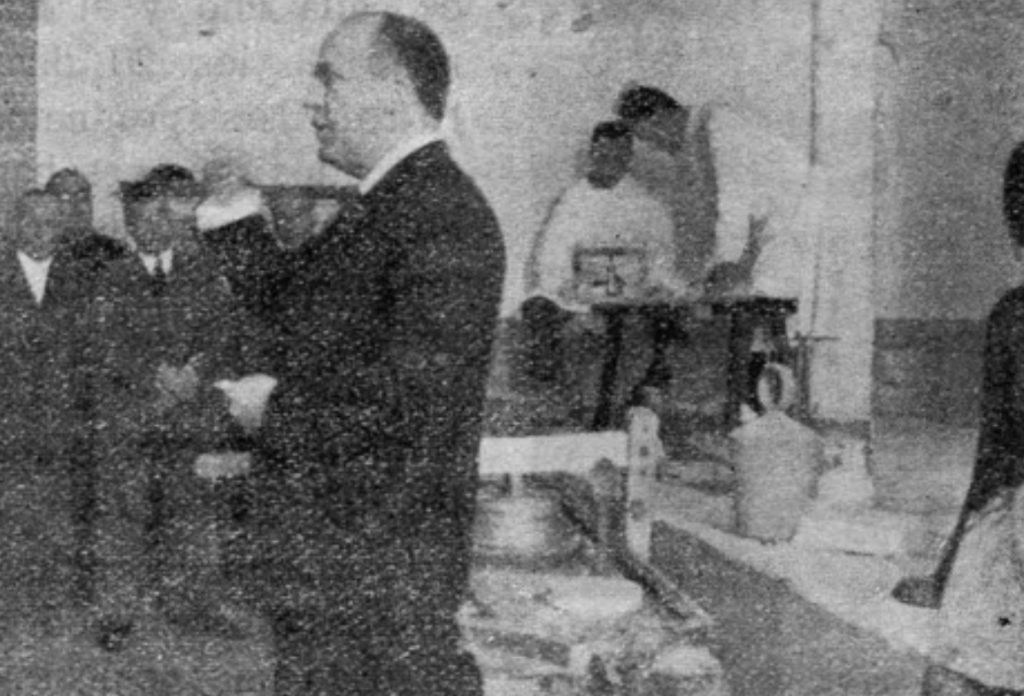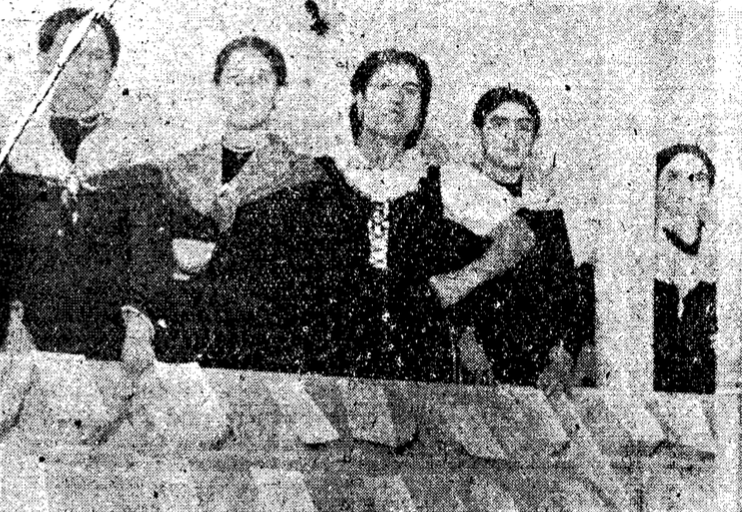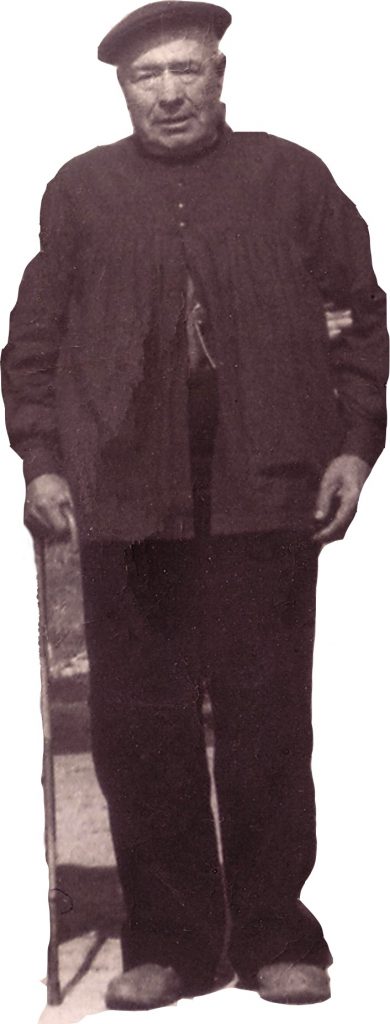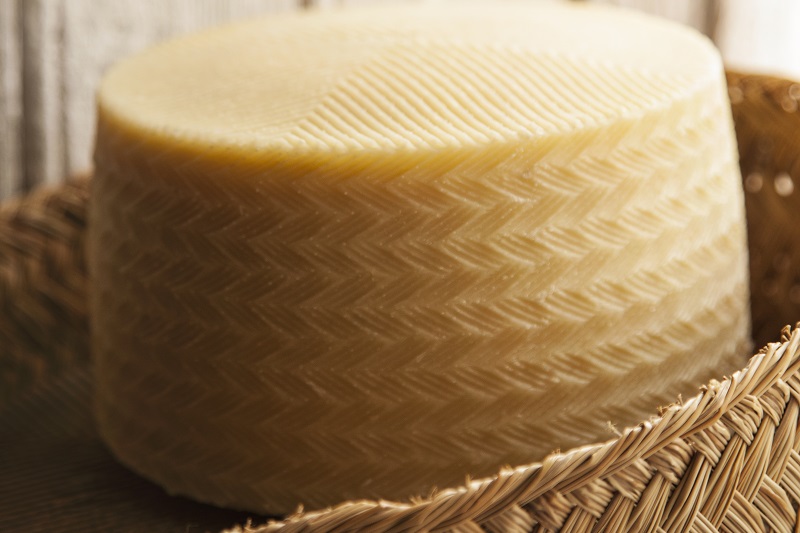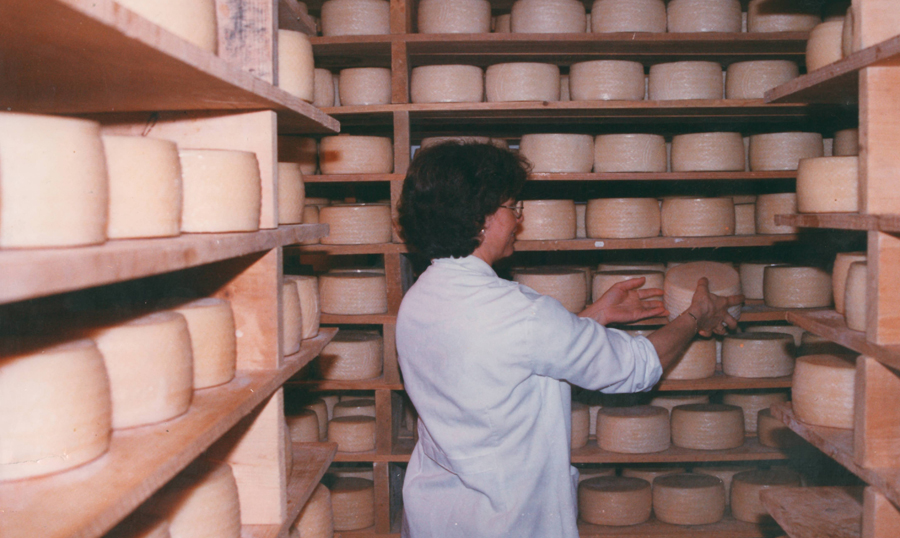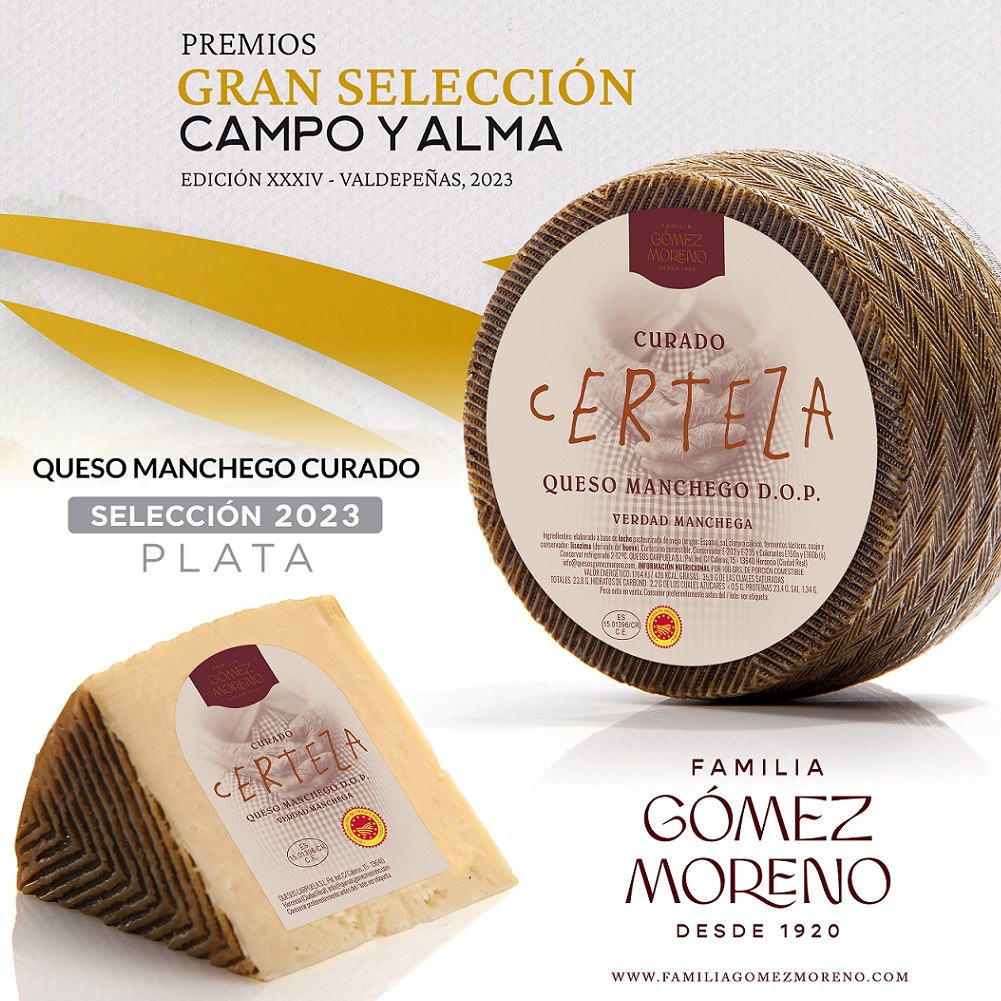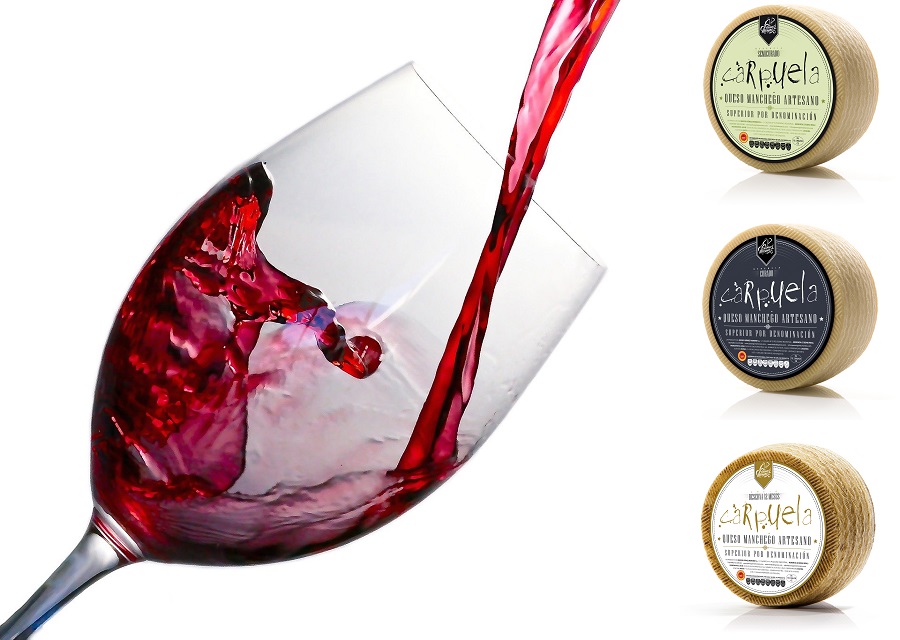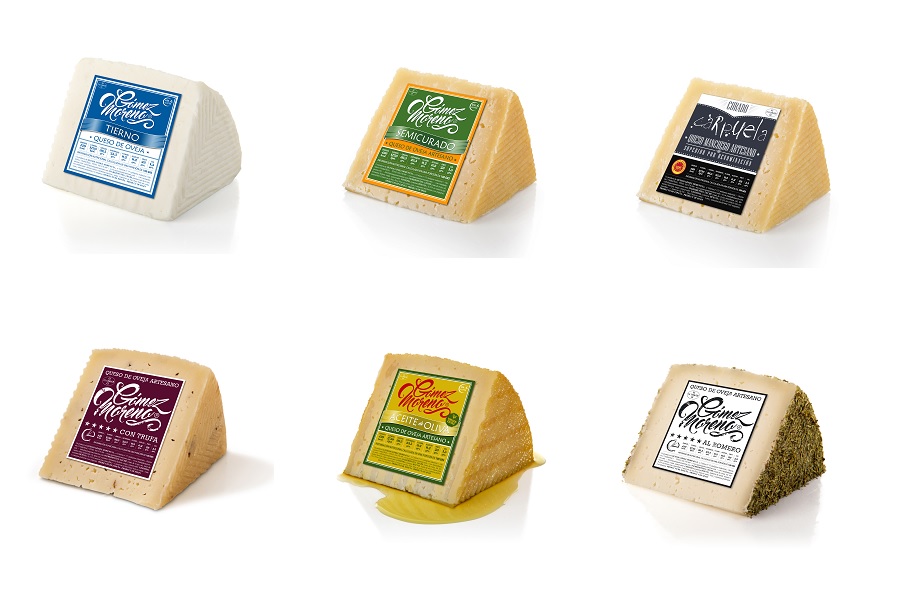Herencia, located in the heart of La Mancha, is a hospitable land, both because of its Hospitaller origins and the warmth of its people. Nestled next to the last foothills of the Montes de Toledo and in the middle of the La Mancha plain, it is surrounded by vast farmlands—cereals, orchards, vineyards, and olive groves—that have, over the centuries, been the economic engine of the town, making its wines, oils, and sweets famous.
It is a land of farmers, but also of cattle breeders and shepherds who, through great effort, have managed to make the most of a harsh and extreme climate, which gives their products unique qualities. The best example of this is found in its renowned cheeses, awarded at regional, national, and international levels, whose production process today stands as the most important intangible heritage of the town.
Speaking of Herencia cheese is to speak of centuries of history and tradition, but also of future and progress. It is to speak of shepherds and breeders, but also of businesspeople and entrepreneurs. It is to speak of a unique product that preserves the essence of an entire population, the wisdom of its people, the strength of its lands, the quality of its herds, and the fragrance of its pastures. In short, it is a product valued and demanded worldwide thanks to the efforts of numerous families with a livestock tradition.
Millennia of history
The exact origin of Herencia cheese cannot be pinpointed. It is the result of centuries of evolution, which have given this unique product its unmatched characteristics. Archaeological studies confirm that 4,000 years ago, during the Bronze Age, cheese making and consumption in this area were common. This is evidenced by the discovery of cheese molds in nearby archaeological sites such as the Motilla del Río Azuer in Daimiel, or two cheese mold fragments from “Cerro Galayos” in Herencia.
The milk used came from the Ovis Aries Ligeriensis, an ancestor of today’s Manchega sheep, which arrived from the north of the Pyrenees and settled in La Mancha. Here, it was domesticated and cared for so that it did not mix with other species, preserving its purity and original qualities, which can still be found in the modern Manchega sheep. The importance of this land and its livestock has therefore been evident since prehistoric times.
Already in medieval times, records are much more abundant. Different studies confirm that during the formation of the Campo de San Juan (13th century), the Hospitaller Order paid special attention to the creation and protection of important pasturelands such as those of Peñarroya, Ruidera, Santa María, and Villacentenos, the latter closely linked to Herencia, which would play a very important role in its use along with Alcázar, Arenas, and Villarta.
During the 16th century, the importance of livestock in the area stagnated, as the priory authorities decided to promote other elements. Nevertheless, from the topographical surveys of Philip II carried out in 1575, it is known that Herencia’s economy was still fundamentally based on livestock and cereal cultivation.
For its part, already in the 18th century, the Descriptions or Relations of Lorenzana from 1782 provide new data on the livestock and cheesemaking importance of Herencia. They indicate the existence of about 7,000 lambs, as well as a production of 1,800 arrobas of wool per year and about 1,000 of cheese.
Also interesting are the studies carried out by Florencio Huerta, Nieves Esther Muela, and Irene Poveda de Campos, which indicate the existence in 1789 of 12,440 head of sheep in Herencia, distributed among 115 owners. Of these, a small number were landowners with large flocks and the greatest number of animals, while the largest group consisted of commoners and laborers owning only a few head.
The following data found correspond to the first half of the 20th century. They come from the industrial registry of the late first third of the century, which lists several residents of Herencia as exclusive cheese sellers. Thus, for example, Isidoro Gallego Aguilera requested permission in January 1928 to sell and export cheeses from Laureano Montes Street (now Carrasco Alcalde). This business shows the importance of Herencia cheese, which was not only consumed locally but also in demand outside the town.
Mr. Isidoro Gallego’s case was not the only one. There are other similar references, such as that of Eusebio González Escribano, who requested permission in April 1928 to sell cheese in a shop on Cervantes Street. A year later, in April 1929, Miguel García-Morato’s son would request permission from the town hall to sell cheese at number 2 San José Street, while Claudio Fernández Chocano started a sheep livestock business in January 1939 on Mesones Street.
Calixto Moraleda and the creation of the Ciudad Real Livestock Station
At this point, it is important to pause at a milestone of vital importance in the history of Herencia cheese. On December 7, 1931, the Provincial and Regional Livestock Stations were created by Royal Decree, with the Ciudad Real station being one of the first to be established. This was largely thanks to Calixto Moraleda Martín-Buitrago, a member of the National Veterinary Corps (2nd graduating class of 1915), a native of Herencia, and the promoter and first director of the Ciudad Real Livestock Station.
From this Livestock Station, he always sought to improve the Manchega sheep breed and, to that end, ordered the purchase—always under his supervision—of several lots of sheep from the Herencia area to form the First National Selection Flock of the Manchega breed.
Calixto Moraleda was also responsible for launching a pioneering project in the region—although already existing in other parts of Europe—namely the creation of a “School of Artisan Cheesemakers” aimed at promoting and encouraging training among the province’s livestock breeders and cheesemakers in order to improve, standardize, and define the production of Manchego cheese, seeking greater growth and perfection of the Manchego cheesemaking industry. This school was under his supervision for many years, and from there, he himself conducted numerous courses for breeders and cheesemakers throughout the province.
From the first provincial cheese-making contest to the signing of international agreements for the protection of Herencia cheese.
The holding of the First Manchego Cheese-Making Contest was another milestone of vital importance in this brief history of Herencia cheese presented here. Organized by the Provincial Board for Livestock Development of Ciudad Real, it was to be held in the town of Herencia since, in the words of Francisco Naranjo Batmale, then Provincial Head of Livestock, “it is no coincidence that this is the cradle, the place of the most venerable tradition in the cheese industry, whose consumption has reached a volume beyond imagined limits.”
Held during the month of June 1945, the contest lasted until mid-July due to its conditions and, above all, the large number of participation requests, which totaled 28. This high demand forced the Provincial Livestock Board to change its initial plans of holding a single joint demonstration. The jury had to travel for several days to the different participating farms in Herencia to study and evaluate all the cheese-making and production processes. This great interest on the part of Herencia’s breeders and cheesemakers allowed the Provincial Livestock Board to achieve its main goal: to launch a campaign in favor of standardizing Manchego cheese.
That 28 applications from Herencia farms were received for this first contest is a strong indication of the importance of livestock and the cheesemaking industry in the town, especially when compared with the applications submitted by other local livestock groups, which in most cases did not exceed two.
The participants in this first Manchego cheese-making contest were: Joaquín del Pozo, Vicente Molina Manzanaro, Rafael M. Corrales, Manuel Fernández Montes, Francisco Moreno-Manzanaro, Teresa Tajuelo, Luis Friginal, Manuel Díaz Paniagua, Widow of Santiago Manzanaro, Bernardo Manzanaro Jiménez, Máximo Moreno-Manzanaro, Juan Antonio González Gallego, José María Jiménez Madero, José María Mateos Alameda, Widow of Reyes Molina, Antonio Mateos García-Morato, José Fernández Conde, Petra Rodríguez Palmero, Manuel Berrio Carrero, Manuel Romero Aragonés, Julián Tajuelo Romero, Sandalio Sosa, Bernardo Moreno-Manzanaro Peral, Pedro José Moreno-Manzanaro, Gabriel Berrio, Dolores Rodríguez Palmero, Máximiano González Gallego, and Gabino Moreno-Manzanaro.
Once the contest had ended, on July 12, 1945, a grand closing and awards ceremony was held in Herencia, attended by the president of the Superior Agricultural Council, the Civil Governor, the President of the Provincial Council, and many other provincial and local authorities.
The winner of the contest, with 79.71 points out of a total of 100, was Joaquín del Pozo Orea (a resident of Madrid), who was awarded the first prize consisting of 1,000 pesetas in cash, two sets (materials and analysis), and the cup of the Hon. Civil Governor. In second place, with 75.63 points, was Vicente Molina Manzanaro, who received 500 pesetas in cash, two sets (materials and analysis), and the cup of the Provincial Board for Livestock Development. Rafael M. Corrales Blanco, with 68.72 points, took third prize, consisting of 250 pesetas and the cup of the Town Hall, while the fourth and final prize, consisting of 250 pesetas and the cup of the Local Board for Livestock Development, went to Manuel Fernández-Montes y Jiménez Mendaño, with 66.35 points.
For the final score, the jury took into account several aspects such as the good construction and hygiene of the cheesemaking facilities, the housing conditions of the livestock, the conditions and proper methods of milking, the coagulation of the cheese, its handling over 25 minutes, the performance of complementary analyses, the fermentation, as well as its smell, flavor, shape, and the distribution and size of its holes, among several other factors.
It is important to note that during the contest there was also a practical demonstration of artisan cheese-making carried out by Mr. Calixto Moraleda, director of the Provincial Livestock Station and President of the Jury. This demonstration aimed to emphasize the need to systematize the cheese-making process using modern manufacturing and analysis equipment suited to new requirements, all with the goal of achieving greater perfection in the final product and reaching the highest quality standards essential for any Manchego cheese.
This contest led many of Herencia’s cheesemakers—already among the most renowned in La Mancha at the time—to adopt many of the new and improved production procedures demonstrated during the event. This meant taking greater care in manufacturing operations, eliminating unhygienic processes, and standardizing the type of cheese to compete in the most demanding markets, which in the long run would make Herencia “the area where the greatest care is taken in its production.”
Thus, for example, master cheesemaker Bernardo Moreno-Manzanaro Peral sought to put into practice everything he had learned about livestock health and hygiene by building several “corrios” or shelters, which he began constructing in 1945 and completed around 1948, in the Madridejos mountains near the area known as Valdehierro. After reaching an agreement with the State allowing his sheep to graze on the best land in this publicly owned mountain range, Bernardo Moreno, better known as “Carpuela,” committed to building these livestock shelters as payment.
Little by little, as the 20th century progressed, Herencia cheese established itself as a brand in its own right within Manchego cheeses. Proof of this is its presence at numerous fairs and competitions, both provincial and national, as well as references to Herencia cheese in various professional publications. The First National Agricultural Fair held in Madrid in 1950 is clear evidence of this. At that event, the Herencia cheesemaking industry was represented, with its livestock operations winning various awards, as attested by the diplomas preserved in the town’s municipal archives.
In 1953, Herencia was also represented at the International Agricultural Fair held in Ciudad Real, where it was reported that its cheese production reached 200,000 to 250,000 kilograms—a significant and noteworthy figure. These impressive production numbers were also backed by the large number of livestock breeders, as well as the existence of several companies dedicated to cheese export. Examples include the factory and warehouse of Hermenegildo García-Morato, that of Victorio García-Morato, the estate of Cerro de La Merced owned by the Mercedarian friars, and that of Isidro Fernández-Cañadas García-Navas—one of the town’s main cheese producers—who, during the 1945 contest, had already provided his warehouse facilities for the maturation of the cheeses entered in the competition.
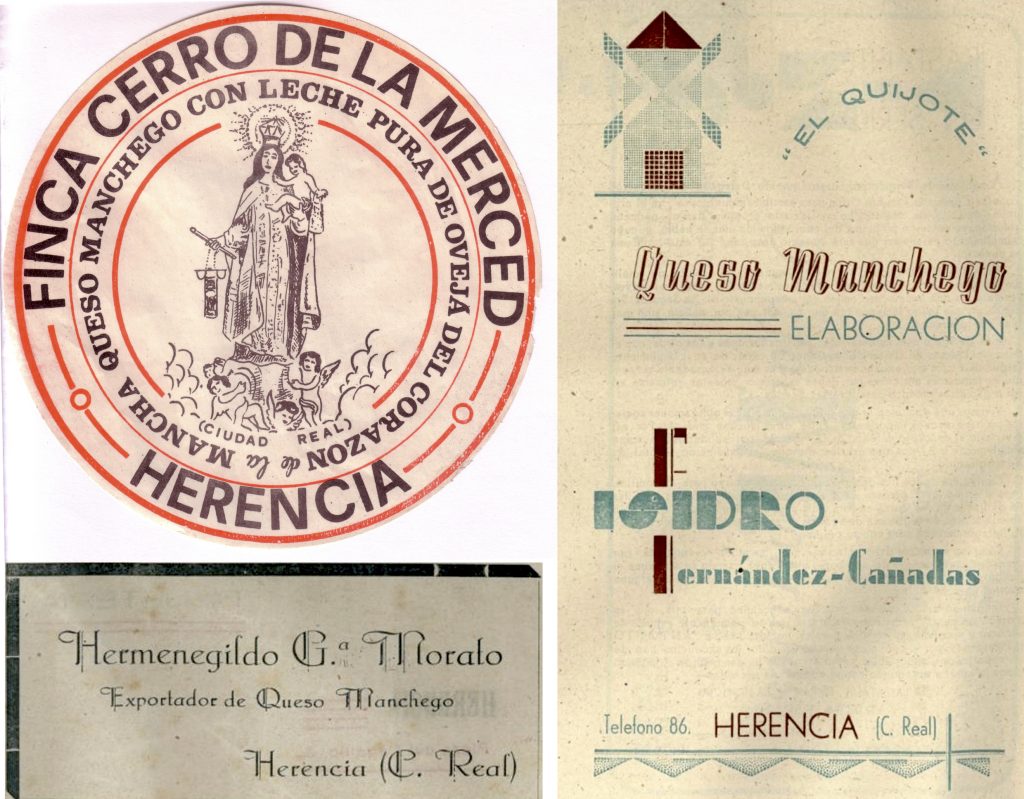
Different images of advertisements and labels of Herencia cheeses taken from various books on the Fairs and Festivals of Herencia and from the book Nuestra Señora de las Mercedes y Herencia. Imágenes, tradición y devoción.
Isidro Fernández-Cañadas would also be the founder, in the mid-20th century, of the town’s first industrial cheesemaking facility, launched in his “El Quijote” cheese factory. There, he applied the most advanced scientific and sanitary standards of the time, including a laboratory for milk analysis. So much so that this factory was chosen by the Office for Livestock Development, in collaboration with the Provincial Council, as the location to film a documentary on Manchego cheese production.
The figure of Bernardo Moreno-Manzanaro Giménez-Ortiz also played a major role in promoting Herencia cheese. He was one of the province’s leading livestock dealers and, of course, also a businessman in the cheese industry. Bernardo Moreno went on to hold important positions such as president of the Provincial Board for Livestock Development, president of the Provincial Livestock Union, National Board Member of the same, president of the Official Agricultural Chamber, provincial deputy on two occasions, and, ultimately, mayor of Herencia from 1966 to 1974. One of his main wishes—and a focus of his work and effort—was the creation of a large cooperative of Herencia livestock breeders to promote and strengthen the town’s cheese industry, a project which, however, he never managed to see completed.
Such was the fame of Herencia cheese that, during the 1970s—specifically between 1970 and 1976—and thanks to reports and negotiations carried out by the Agrarian Union Chamber, the Chamber of Commerce, and other provincial entities, several international bilateral treaties were signed concerning the “Protection of indications of origin, designations of origin, and other geographical indications,” and the names “Manchego cheese” and “Herencia cheese” always appeared. Thus, an agreement and protocol were signed with the Federal Republic of Germany in 1970, a convention with France in 1973, an agreement with Switzerland in 1974, and agreements and protocols with Italy and Austria in 1975 and 1976, respectively.
Throughout this process, which began in 1945 with the call for the First Manchego Cheese-Making Contest, efforts were made to systematize the characteristics of this unique product and ensure they were protected, endorsed, and regulated under a Designation of Origin. Thus, in 1985, the Manchego Cheese Designation of Origin was created—but only after hard work to unite numerous livestock breeders and cheesemakers from various provinces in La Mancha and to obtain multiple permits and national recognitions. From that moment on, several cheesemakers from Herencia joined the new Designation of Origin, becoming some of its main supporters and achieving high levels of quality recognized internationally.
Herencia Cheese in the 21st Century
Today, Herencia cheese enjoys exceptional prestige within the Manchego Cheese Designation of Origin, thanks to its ability to meet the highest hygienic and sanitary standards while preserving the essence of a cheesemaking tradition that spans centuries.
There are currently four cheesemaking companies in the municipality, characterized by their use of Manchega sheep and strict selection of natural pastures: Quesos Gómez Moreno, Quesera Herenciana Cofer, Quesos Iniesta Manzanaro, and Quesería 1605.
It is worth noting that today all the cheesemaking companies in the town are backed by an important artisanal cheesemaking tradition that preserves the essence and flavor of the renowned Herencia cheese. Equally important is their strong commitment to modernizing their facilities, with significant investments aimed at meticulously overseeing every detail of the production chain—from the care of the sheep to the final marketing of the product—covering milking, milk transport, the cheesemaking process, maturation, and storage, as well as the design and branding work, which stand out for their quality and exquisite attention to detail.
With all this, Herencia cheese is today considered a true gastronomic jewel and, without a doubt, the town’s most important ambassador, carrying its name around the world. Herencia cheese has been recognized not only in numerous food contests and fairs in Spain—such as Fercam, Gran Selección, and Expovicam—but also in the most prestigious international awards. Proof of this is the presence of Herencia’s Manchego cheeses in the most important international competition, the World Cheese Awards, which evaluates cheeses from all over the world and where Herencia cheeses have always played a prominent role, winning on more than one occasion the most important recognitions, both for the products of Quesos Gómez-Moreno and those of the company Quesera Herenciana Cofer.
Also noteworthy is the current presence of Herencia’s cheesemaking companies at major national food industry fairs such as “España Original” in Ciudad Real and “Alimentaria” in Barcelona, as well as at other international events in Europe and the United States, such as the “Summer Fancy Food” in New York, where Quesos Gómez Moreno has been featured on several occasions in a clear effort to promote the international marketing of its products. All this means that Herencia cheeses, through their different companies, are exported to numerous countries in Europe and Latin America, as well as to the United States, Russia, China, and Japan.
In addition, in their constant work of innovation, Herencia’s cheesemakers have managed to adapt to market demands by launching new products of great artisanal quality. Some examples include rosemary sheep’s cheese and lard-cured cheese, which, along with their lines of cheese spreads, join the already traditional fresh, semi-cured, cured, aged, and oil-preserved cheeses.
Everything said so far is only a brief outline of the importance and impact of Herencia cheese. Its production process is a true intangible heritage that treasures the experience and dedication of countless generations of livestock breeders and cheesemakers who have preserved the essence of a centuries-old tradition. A fundamental driver of the local economy for centuries, today it is the most important ambassador of the entire town of Herencia, as well as one of the main emblems of its culture and history.
Author: Claro Manuel Fdez.-Caballero Martín-Buitrago (B.A. in Art History and professor of Local History at the Universidad Popular)
Source and bibliography in: “El queso de Herencia, patrimonio inmaterial” in Ferias y Fiestas Herencia 2015. Herencia, Herencia Town Council, 2015.


